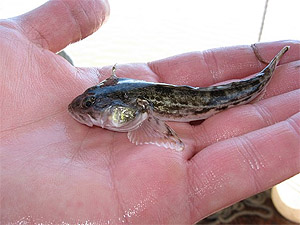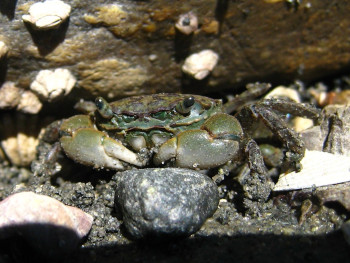
|
|||||||||||||||
|
| |||||||||||||||
Runoff dilutes and fertilizes estuary waters Coastal estuaries such as Elkhorn Slough become less salty in the winter, as fresh water flows down from the surrounding watersheds. Sometimes this fresh water forms a thin layer at the surface, while saltier ocean water remains below. A series of heavy rains, however, can fill practically the entire estuary with muddy, brackish water. This muddy water may look nasty, and it sometimes does carry toxic chemicals, fertilizer, and human and animal waste into estuaries. But it also brings sediment that builds up the mud flats, as well as organic matter that provides food for numerous decomposers and bottom-feeding animals in the slough. Finally, the turbid water may provide some visual protection from predators for small fish and other animals that live in the shallow waters of the slough. Staghorn sculpin and herring use estuaries as nursery areas Even in the middle of winter, Elkhorn slough and other estuaries serve as fish nurseries. Staghorn sculpin and herring enter the slough in early winter and then lay eggs in December or January in the shallow waters of the upper Slough, or even in streams that feed into the slough. Both the spawning fish and their young provide essential winter food for birds, sea lions, and other predators. Staghorn sculpin lay eggs Pacific staghorn sculpin (Leptocuttus armatus) are probably the most common fish found in the upper Elkhorn Slough. Although some staghorn sculpin live in the slough all year long, many more adult sculpin live in the sandy seafloor just offshore of the beaches of central Monterey Bay.  A young staghorn sculpin. (Source: Amber Manfree/UC Davis ) These five- to eight-inch-long greenish brown fish spend most of their time lurking in little burrows in the seafloor, with just their head and eyes exposed. They lie in wait for prey such as small worms, crabs, amphipods, and even young anchovies. In winter, staghorn sculpin migrate from the ocean into Elkhorn slough and other coastal estuaries to lay their eggs. During January or February, each female lays between 2,000 and 10,000 eggs in a sticky mass. Often the eggs are laid near underwater vegetation such as eel grass. After a male sculpin fertilizes the eggs, he guards them for about ten days, until they hatch. After the eggs hatch, most of the male and female adult sculpin leave the slough and head back out to sea. The eggs hatch to release tiny sculpin larvae, about 1/10 of an inch long. These larvae will spend the next two months in the upper portions of Elkhorn slough and tributary streams. At first they can only drift with the currents, but soon they will be swimming around. Most of these sculpin larvae will be eaten by other animals in the slough . Those that survive will become juveniles by March or April. These juvenile sculpin will spend another month or two in the slough before heading out into the nearshore waters in late spring or summer. Pacific herring lay eggs in estuaries, then head back out to sea Pacific herring (Clupea pallasii follow a similar migration schedule as staghorn sculpin, spending most of the year in the open ocean, but moving into coastal estuaries such as San Francisco Bay and Elkhorn Slough in winter to breed. Herring often lay their eggs within beds of eel grass and the filamentous red alga known as Gracilariopsis (which is particularly abundant in winter). The spawning herring supply essential food for California sea lions which migrate into Central Coast estuaries in winter to feed on this delicacy. After laying eggs in shallow water (typically in December or January), the adult herring head back out to sea in March, leaving their young behind in the estuarine nursery areas. The herring are particularly susceptible to predation at this time of year because they are still weak from the effort of spawning and several months of limited food. As they gather just outside the Golden Gate to feed, the herring provide essential seasonal food for king salmon who are fattening up before making their spawning run during the upcoming fall. Note: In the course of the year, herring and northern anchovies alternate using San Francisco Bay as a nursery area--herring release eggs during the winter months and anchovies release eggs in spring and summer. In late February, as northern anchovies are gathering offshore of San Francisco Bay in preparation for spawning, herring are just leaving the bay. Mud crabs, cancer crabs, and pea crabs release their eggs Throughout the winter months, many shallow-water crabs in coastal estuaries brood their eggs under their shells. By January, these crab eggs are beginning to hatch, releasing microscopic larvae into the protected waters of the estuary. The eggs of some crabs hatch at dawn or dusk. This may reduce the chance that the newly hatched larvae will be eaten by predators that rely on sunlight to see their prey. Other crab eggs hatch at full moon or new moon, when tidal currents within the slough are strongest. With all these hatching crab eggs, the waters of Elkhorn Slough contain more crab larvae in January than at any other time of year. Most of these crab larvae are found in the inner parts of Elkhorn Slough. It is not clear whether the female crabs move into the upper slough when their eggs are about to hatch, or the larvae somehow move with the currents to become concentrated in these areas. Mud-flat crabs carry eggs Mud-flat crabs (Hemigrapsus oregonensis) play a key role in food webs within the Slough, providing food for many of the larger fishes and birds that forage in the slough waters. Their yellowish-gray bodies blend in with the mud and the beds of eel-grass and green algae where they live. When threatened, they (like many creatures of the slough) retreat into burrows in the mud.  A mud-flat crab among rocks and shell debris. (Source: Cair/Wikimedia ) You can often find female mud-flat crabs carrying eggs from November through February. These eggs typically hatch in January or February, releasing microscopic larvae that swim around the waters of the upper slough for a month or two before settling down to the muddy bottom in April or May. Cancer crabs carry eggs Two different cancer crabs, the bubble crab (Cancer antennarius) and the graceful crab (Cancer gracilis), also carry eggs through the winter months and release their young in January or February. Graceful crabs mate in November. For the next two or three months, the male crab protects the female crab while she carries her load of eggs. After the eggs hatch, the young swim around the upper slough, but gradually migrate toward the lower slough as spring progresses. By May the few surviving late-stage larvae of the graceful crabs will have migrated to near the mouth of the slough, and will be just about ready to settle down to the seafloor. Like the mud-flat crab, the graceful crab often makes its home in mud flats or eel-grass beds, and provides important food for larger animals such as flatfish and rays. Pea crabs carry eggs A variety of tiny "pea crabs" (most in the genus Pinnixa) live within Elkhorn Slough and other coastal estuaries. They are arguably the most common type of crab in the slough, but they are so tiny (their bodies are often less than a quarter inch across) that they are easy to overlook. They also tend to live within the burrows, or even within the bodies of other animals, which makes them hard to spot. Like the other crabs in the slough, the pea crabs carry eggs throughout the winter. Their eggs seem to hatch in waves throughout the winter season, with the largest wave occurring in late January. One pea crab (Pinnixa franciscana) lives in worm burrows, and has three distinct hatchings a year--in late November, late January, and late March. The newly hatched pea crabs spend only about two or three weeks as drifting larvae (mostly in the upper slough) before settling down to find a home in a worm burrow. Another type of pea crab, Pinnixa weymouthi, has never been seen inside Elkhorn Slough as an adult. However, every two weeks (at full and new moon) between January and March, pulses of larvae from this crab are carried into the slough by the tidal currents. The larvae apparently develop within the slough, then leave after just a few weeks, to colonize abandoned worm tubes on the seafloor outside the slough. Sandpipers, dunlins, and other early migrating birds use estuaries as rest and feeding stops Coastal estuaries provide a winter home and feeding ground for many coastal birds such as sandpipers, willets, godwits, whimbrels, and dunlins. By late February, flocks of migrating wetland and shore birds begin to arrive in Central Coast estuaries as they migrate north to breeding areas in the Arctic. Some of the most numerous of these wetland birds are sandpipers (Calidris mauri). These small scurrying birds look much like the little sanderlings that chase the waves on sandy beaches. However, sandpipers usually forage on mudflats, following the receding tide. They reach maximum numbers in Elkhorn Slough during February and March. Another early migrating wetland bird that you are likely to see in the slough at this time of year are dunlins (Calidris alpina). Some of these wading birds spend their winters in Elkhorn Slough, where they are joined by flocks of their northward migrating relatives in February or March. By April they will have left the area to breed, and will not return until September. |
